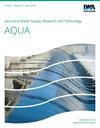Evaluation of the groundwater recharge potential zone by using the GIS and remote sensing in the Ziway Abijata sub-basin, Central Rift Valley of Ethiopia
IF 4.3
Q2 Environmental Science
引用次数: 0
Abstract
Groundwater is fresh water that is stored in an underground zone, which is less vulnerable to pollution than surface water and communally used for economic, social, and ecological purposes. This study aimed to evaluate groundwater recharge potential by using a geographic information system (GIS) and remote sensing in the Ziway Abijata sub-basin, Central Rift Valley of Ethiopia. In the present study, six parameters such as soil drainage, slope, lineament density, drainage density, soil texture, and land use land cover were used. ArcGIS 10.3, ERDAS Imagine 2015, IDRISI Selva 17, Arc SWAT 10.3, and Google Earth Pro were applied. The results revealed that about 58 km2 (2.1%) and 1442.5 km2 (53.9%) were ranked as excellent and good for the groundwater recharge potential. Consequently, about 1183.2 km2 (43.4%) was covered by a moderate groundwater recharge zone. Larger parts of the study area were dominated by good and moderate groundwater recharge zones. Based on the results of this study, we recommended that the decision-makers, environmentalists, geologists, and other stakeholders will have a critical role in the improvements of the future sustainability and proper management of groundwater in the study area. Further researchers can investigate other remaining ecological parameters and socio-economic data that were not included in the present study.基于GIS和遥感的埃塞俄比亚中部裂谷Ziway Abijata次盆地地下水补给潜力区评价
地下水是储存在地下区域的淡水,它比地表水更不容易受到污染,通常用于经济、社会和生态目的。本研究旨在利用地理信息系统(GIS)和遥感技术对埃塞俄比亚中部裂谷Ziway Abijata子流域地下水补给潜力进行评价。本研究采用土壤排水、坡度、线状密度、排水密度、土壤质地、土地利用、土地覆被等6个参数。应用ArcGIS 10.3、ERDAS Imagine 2015、IDRISI Selva 17、Arc SWAT 10.3和Google Earth Pro。结果表明:地下水补给潜力优、良区分别为58 km2(2.1%)和1442.5 km2 (53.9%);因此,约1183.2 km2(43.4%)为中等地下水补给带。研究区大部分地区以地下水补给良好和中等补给带为主。基于研究结果,我们建议决策者、环保主义者、地质学家和其他利益相关者在改善研究区未来地下水的可持续性和适当管理方面发挥关键作用。进一步的研究人员可以调查其他未包括在本研究中的生态参数和社会经济数据。
本文章由计算机程序翻译,如有差异,请以英文原文为准。
求助全文
约1分钟内获得全文
求助全文
来源期刊
CiteScore
4.70
自引率
0.00%
发文量
74
审稿时长
4.5 months
期刊介绍:
Journal of Water Supply: Research and Technology - Aqua publishes peer-reviewed scientific & technical, review, and practical/ operational papers dealing with research and development in water supply technology and management, including economics, training and public relations on a national and international level.

 求助内容:
求助内容: 应助结果提醒方式:
应助结果提醒方式:


